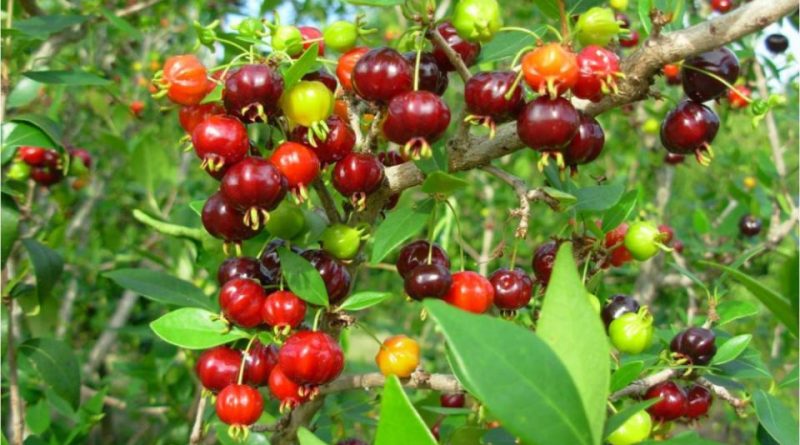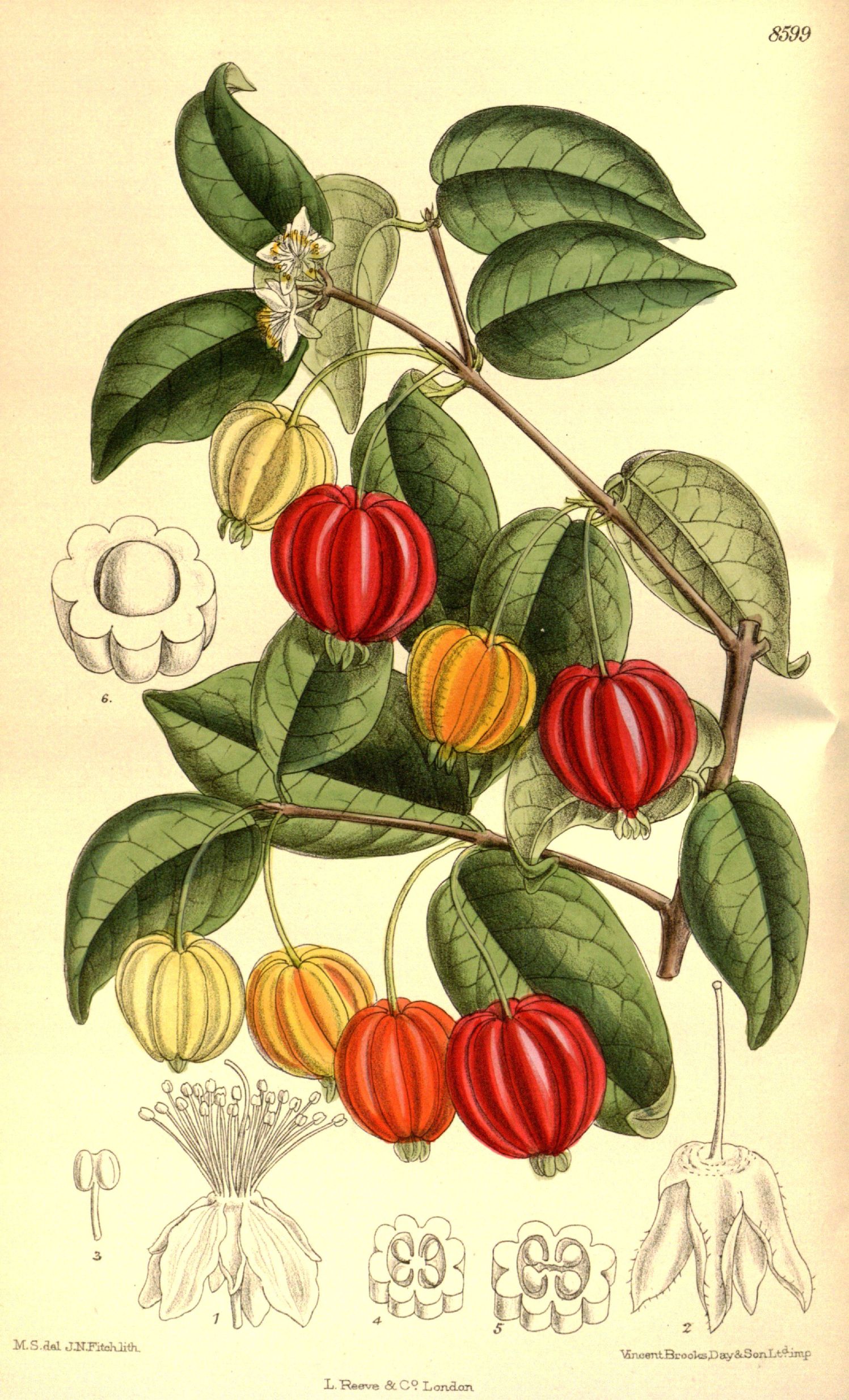Eugenia uniflora
Eugenia uniflora
The pitanga o Suriname cherry, (Eugenia uniflora L.) is an arboreal species belonging to the Myrtaceae family.
Systematics –
From a systematic point of view it belongs to:
Eukaryota Domain,
Kingdom Plantae,
Subarign Tracheobionta,
Spermatophyta superdivision,
Magnoliophyta Division,
Magnoliopsida class,
Subclass Rosidae,
Order Myrtales,
Myrtaceae family,
Genus Eugenia
E. uniflora species.
The terms are synonymous:
– Eugenia arechavaletae Herter;
– Eugenia costata Cambess .;
– Eugenia dasyblasta (O.Berg) Nied .;
– Eugenia decidua Merr .;
– Eugenia indicates Nicheli;
– Eugenia lacustris Barb. Rodr .;
– Eugenia michelii Lam .;
– Eugenia microphylla Barb. Rodr .;
– Eugenia myrtifolia Salisb .;
– Eugenia oblongifolia (O.Berg) Arechav .;
– Eugenia oblongifolia (O.Berg) Nied. nom. illegally;
– Eugenia strigosa (O.Berg) Arechav .;
– Eugenia willdenowii (Spreng.) DC. nom. illegally;
– Eugenia zeylanica Willd .;
– Luma arechavaletae (Herter) Herter;
– Luma costata (Cambess.) Herter;
– Luma dasyblasta (O.Berg) Herter;
– Luma strigosa (O.Berg) Herter;
– Brazilian Myrtus L .;
– Myrtus willdenowii Spreng .;
– Plinia pedunculata L.f .;
– Plinia petiolata L. nom. illegally;
– Plinia rubra L .;
– Plinia tetrapetala L .;
– Stenocalyx affinis O.Berg;
– Stenocalyx brunneus O.Berg;
– Stenocalyx costatus (Cambess.) O.Berg;
– Stenocalyx dasyblastus O.Berg;
– Stenocalyx glaber O.Berg;
– Stenocalyx impunctatus O.Berg;
– Stenocalyx lucidus O.Berg;
– Stenocalyx michelii (Lam.) O.Berg;
– Stenocalyx nhampiri Barb. Rodr .;
– Stenocalyx oblongifolius O.Berg;
– Stenocalyx rhampiri Barb.Rodr .;
– Stenocalyx ruber (L.) Kausel;
– Stenocalyx strigosus O.Berg;
– Stenocalyx uniflorus (L.) Kausel;
– Syzygium michelii (Lam.) Duthie.
Etymology –
The term Eugenia was given in honor of Prince Eugene of Savoy Soissons (1663-1736), a soldier in the service of the Habsburgs where he reached the top of the command.
The specific uniflora epithet comes from ūnus uno and from flos, flóris fiore: with a single flower or inflorescence, as opposed to other congeneric species.
Geographic Distribution and Habitat –
The Eugenia uniflora plant is an evergreen tree native to the east coast of tropical South America, ranging from Suriname, French Guiana to southern Brazil, as well as Uruguay and parts of Paraguay and Argentina.
The tree was introduced to Bermuda for ornamental purposes but is now out of control and is listed as an invasive species. It has also been introduced in Florida.
Its natural habitat is that of the edges of forests or along the banks of rivers, forming dense thickets.
Description –
Eugenia uniflora is a plant that grows in the form of an evergreen tree or shrub up to 6-8 m in height and which in cultivation also remains lower and very branched.
It has a thick crown with leaves, on a 0.2-0.4 cm long petiole, opposite, simple, ovate to ovate-lanceolate with entire margin, 2-5 cm long and 1-3 cm broad, initially colored rosy bronze then glossy intense green above, lighter below, rather leathery and aromatic. During the winter the leaves turn red.
The flowers are axillary, bisexual, solitary or fasciculated carried on a 1,5-3 cm long peduncle, with persistent calyx with 4 retroflexed lobes about 0,4 cm long, corolla with 4 obovate white petals, about 1 cm long, ephemeral, and numerous stamens 0,8 cm long.
The fruit is a globular berry with a flattened shape at the two poles, generally with 8 longitudinal ribs, 1.5 cm long and 2-4 cm wide; this is initially green, then orange and finally red when ripe, with a thin skin and juicy red pulp, with a sweet to sour taste, slightly resinous, usually containing a globose seed, rarely 2-3, of 0.5-1 cm in diameter.
Cultivation –
Pitanga is a plant that generally reproduces by seed, which has a short-term germination capability, about a month, and germinates in 3-4 weeks: the first flowering occurs after 2-4 years in the best cultivation conditions. It can reproduce to a lesser extent by cutting and layering.
It spreads easily through birds and small mammals and in many areas of the tropics it has escaped cultivation, becoming naturalized and in some cases becoming a pest.
For its cultivation it requires exposure in full sun, a temperature that must never drop below -5 ° C for adult plants. It requires a soft, draining and moderately organic soil and should be watered in order to keep the soil constantly humid, avoiding water stagnation.
Well rooted plants can bear dry periods, but with regular watering the fruits are larger and less acidulous.
Due to its biological characteristics, it can also be marginally cultivated in areas with a Mediterranean climate.
Customs and Traditions –
Eugenia uniflora is the most cultivated of the genus in tropical and subtropical countries due to its ornamental characteristics, in particular its foliage, rather than its edible fruits, and its adaptability to a great variety of soils. It is a fast-growing plant and is often used for hedges, even low, and border barriers, as it tolerates pruning well, even if drastic.
The fruits, which wither quickly, must be harvested when they are perfectly ripe; fresh fruits therefore have a limited consumption and are often consumed in the form of juices, ice creams, syrups, jams and jellies. In Brazil, an alcoholic drink is made from fermented juice. The leaves are used in traditional medicine; the bark contains about 20% of tannin, sometimes used for the tanning of hides.
When the leaves and branches are crushed or cut, they give off a spicy resinous fragrance, which can cause respiratory distress in sensitive individuals.
The fruits rich in vitamins C and A and the leaves have medicinal properties.
In Brazil, the leaves are scattered on the floors of the house so that when they are trampled under the feet, they give off a smell that repels flies.
The leaves are also used for tea in certain parts of Uruguay.
Some research has been done on this plant. According to some medical studies, Eugenia uniflora has several significant pharmacological properties. Its essential oil is antihypertensive, antidiabetic, antitumor and analgesic and has also shown antiviral and antifungal activity.
In vitro it has been shown to be effective against microorganisms such as Trichomonas gallinae, Trypanosoma cruzi and Leishmania amazonensis.
It also displays significant anti-inflammatory properties, and is widely used as a folk remedy in South America for stomach ailments.
Preparation Method –
Pitanga has various uses in both food and medicine.
The fruits can be eaten fresh and picked when they are perfectly ripe; the fresh fruits, due to the quick perishable nature, have a limited consumption; therefore they are often consumed in the form of juices, ice creams, syrups, jams and jellies.
In Brazil an alcoholic drink is made from fermented juice. The leaves are used in traditional medicine; the bark is sometimes used for leather tanning.
In Brazil the leaves are used for their resinous fragrance for local perfumers and to keep insects away.
Guido Bissanti
Sources
– Acta Plantarum – Flora of the Italian Regions.
– Wikipedia, the free encyclopedia.
– Useful Tropical Plants Database.
– Conti F., Abbate G., Alessandrini A., Blasi C. (edited by), 2005. An annotated checklist of the Italian vascular flora, Palombi Editore.
– Pignatti S., 1982. Flora of Italy, Edagricole, Bologna.
– Treben M., 2000. Health from the Lord’s Pharmacy, Advice and experiences with medicinal herbs, Ennsthaler Editore.
Warning: Pharmaceutical applications and alimurgical uses are indicated for informational purposes only, they do not represent in any way a medical prescription; therefore no responsibility is taken for their use for curative, aesthetic or food purposes.


